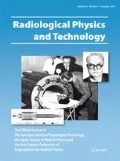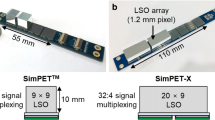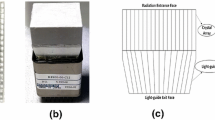Abstract
In the development of depth-of-interaction (DOI)-positron emission tomography (PET) detectors, one of the important steps toward their practical use is an evaluation of their imaging performance, such as the spatial resolution as measured by use of a point source and a one-pair experimental system which simulates actual PET geometries. The DOI-PET detectors have a broad field of view providing good imaging performance compared with conventional detectors. Therefore, evaluation including the region from the center to the periphery close to the detector ring is required in an effort to show their advanced performance regarding uniform spatial resolution. In this study, we aimed to develop and evaluate an efficient one-pair experimental system for demonstration of the DOI-PET detector performance. For this purpose, we propose a one-pair experimental system that can simulate an arbitrary ring diameter and acquire projection data efficiently by skipping unnecessary combinations according to the position of the point source. As a result, the proposed system and our measuring scheme could significantly reduce the total measurement time, especially for a large ring size such as that used in brain PET scanners and whole-body PET scanners. We used the system to evaluate the X’tal cube PET detector with a 2-mm cubic crystal array arranged in simulated PET geometries with ring diameters of 8.2 and 14.6 cm for 12 and 18 detector blocks, respectively. The results showed that a uniform spatial resolution was achieved even in the peripheral region, and measurements were obtained semi-automatically in a short time.









Similar content being viewed by others
References
Murayama H, Ishibachi H, Uchida H, Omura T, Yamashita T. Depth encoding multicrystal detectors for PET. IEEE Trans Nucl Sci. 1998;45:1152–7.
Tsuda T, Murayama H, Kitamura K, Yamaya T, Yoshida E, Omura T, et al. A four-layer depth of interaction detector block for small animal PET. IEEE Trans Nucl Sci. 2004;51:2537–42.
Yamaya T, Yoshida E, Sato M, Tsuda T, Kitamura K, Hagiwara N, et al. Imaging performance evaluation of the jPET-D4 one-ring prototype by the DOI Compression (DOIC) method. Med Imaging Tech. 2005;23:185–93 (in Japanese).
Yamaya T, Hagiwara N, Obi T, Tsuda T, Kitamura K, Hasegawa T, et al. Preliminary resolution performance of the prototype system for a 4-layer DOI-PET scanner: jPET-D4. IEEE Trans Nucl Sci. 2006;53:1123–8.
Nishikido F, Tsuda T, Yoshida E, Inadama N, Shibuya K, Yamaya T, et al. Spatial resolution evaluation with a pair of two four-layer DOI detectors for small animal PET scanner: jPET-RD. Nucl Instrum Methods Phys Res Sect A. 2008;584:212–8.
Nishikido F, Inadama N, Oda I, Shibuya K, Yoshida E, Yamaya T, et al. Four-layer depth-of-interaction PET detector for high resolution PET using a multi-pixel S8550 avalanche photodiode. Nucl Instrum Methods Phys Res A. 2010;621:570–5.
Yamaya T, Mitsuhashi T, Matsumoto T, Inadama N, Nishikido F, Yoshida E, et al. A SiPM-based isotropic-3D PET detector X’tal cube with a three-dimensional array of 1 mm3 crystals. Phys Med Biol. 2011;56:6793–807.
Yazaki Y, Inadama N, Nishikido F, Mitsuhashi T, Suga M, Shibuya K, et al. Development of the X’tal cube: a 3D position-sensitive radiation detector with all-surface MPPC readout. IEEE Trans Nucl Sci. 2012;59:462–8.
Yoshida E, Hirano Y, Tashima H, Watanabe M, Nishikido F, Murayama H, et al. Impact of the X’tal cube detector with isotropic resolution on PET image resolution. J Nucl Med. 2012;53 Supplement(1):49.
Yoshida E, Hirano Y, Tashima H, Inadama N, Nishikido F, Moriya T, et al. Impact of the laser-processed X’tal cube detector on PET imaging in a one-pair prototype system. IEEE Trans Nucl Sci. 2013;60:3172–80.
Yoshida E, Tashima H, Hirano Y, Inadama N, Nishikido F, Muraya H, et al. Spatial resolution limits for the isotropic-3D PET detector X’tal cube. Nucl Instrum Methods Phys Res A. 2013;728:107–11.
Yoshida E, Tashima H, Inadama N, Nishikido F, Moriya T, Omura T, et al. Intrinsic spatial resolution evaluation of the X’tal cube PET detector based on a 3D crystal block segmented by laser processing. Rad Phys Tech. 2013;6:21–7.
Hirano Y, Inadama N, Yoshida E, Nishikido F, Murayama H, Watanabe M, et al. Potential for reducing the numbers of SiPM readout surfaces of laser-processed X’tal cube PET detectors. Phys Med Biol. 2013;58:1361–74.
Carrier C, Martel C, Schmitt D, Leconte R. Design of a high resolution positron emission tomograph using solid state scintillation detectors. IEEE Trans Nucl Sci. 1988;35:685–90.
Yamashita T, Watanabe M, Shimizu K, Uchida H. High resolution block detectors for PET. IEEE Trans Nucl Sci. 1990;37:589–93.
Moses WW, Derenzo SE, Melcher CL, Manente RA. A room temperature LSO/PIN photodiode PET detector module that measures depth of interaction. IEEE Trans Nucl Sci. 1995;42:1085–9.
Miyaoka RS, Lewellen TK, Yu H, McDaniel DL. Design of a depth of interaction (DOI) PET detector module. IEEE Trans Nucl Sci. 1998;45:1069–73.
Yamamoto S, Ishibashi H. A GSO depth of interaction detector for PET. IEEE Trans Nucl Sci. 1998;45:1078–82.
Clément D, Frei R, Loude J-F, Morel C. Development of a 3D position sensitive scintillation detector using neural networks. IEEE Nucl Sci Symp Conf Rec. 1998;3:1448–52.
Schmand M, Eriksson L, Casey ME, Andreaco MS, Melcher C, Wienhard K, Flügge G, Nutt R. Performance results of a new DOI detector block for a high resolution PET—LSO research tomograph HRRT. IEEE Trans Nucl Sci. 1998;45:3000–6.
Seidel J, Vaquero JJ, Siegel S, Gandler WR, Green MV. Depth identification accuracy of a three layer phoswich PET detector module. IEEE Trans Nucl Sci. 1999;46:485–90.
Saoudi A, Pepin CM, Dion F, Bentourkia M, Lecomte R, Andreaco M, et al. Investigation of depth-of-interaction by pulse shape discrimination in multicrystal detectors read out by avalanche photodiodes. IEEE Trans Nucl Sci. 1999;46:462–7.
Shao Y, Silverman RW, Farrell R, Cirignano L, Grazioso R, Shah KS, et al. Design studies of a high resolution PET detector using APD arrays. IEEE Trans Nucl Sci. 2000;47:1051–7.
Liu H, Omura T, Watanabe M, Yamashita T. Development of a depth of interaction detector for γ-rays. Nucl Instrum Methods Phys Res A. 2001;459:182–90.
Levin CS. Design of a high-resolution and high-sensitivity scintillation crystal array for PET with nearly complete light collection. IEEE Trans Nucl Sci. 2002;49:2236–43.
Fremout AAR, Chen R, Bruyndonckx P, Tavernier SPK. Spatial resolution and depth-of-interaction studies with a PET detector module composed of LSO and an APD array. IEEE Trans Nucl Sci. 2002;49:131–8.
Dokhale PA, Silverman RW, Shah KS, Grazioso R, Farrell R, Glodo J, et al. Performance measurements of a depth-encoding PET detector module based on position-sensitive avalanche photodiode read-out. Phys Med Biol. 2004;49:4293–304.
Bruyndonckx P, Léonard S, Tavernier S, Lemaître C, Devroede O, Wu Y, et al. Neural network-based position estimators for PET detectors using monolithic LSO blocks. IEEE Trans Nucl Sci. 2004;51:2520–5.
Ohi J, Tonami H. Investigation of a whole-body DOI-PET system. Nucl Instrum Methods Phys Res A. 2007;571:223–6.
Lerche CW, Döring M, Ros A, Herrero V, Gadea R, Aliaga RJ, et al. Depth of interaction detection for γ-ray imaging. Nucl Instrum Methods Phys Res A. 2009;600:624–34.
Maas MC, Schaart DR, van der Laan DJJ, Bruyndonckx P, Lemaître C, Beekman FJ, et al. Monolithic scintillator PET detectors with intrinsic depth-of-interaction correction. Phys Med Biol. 2009;54:1893–908.
Schaart DR, van Dam HT, Seifert S, Vinke R, Dendooven P, Löhner H, et al. A novel, SiPM-array-based, monolithic scintillator detector for PET. Phys Med Biol. 2009;54:3501–12.
van Dam HT, Seifert S, Vinke R, Dendooven P, Löhner H, Beekman FJ, et al. A practical method for depth of interaction determination in monolithic scintillator PET detectors. Phys Med Biol. 2009;56:4135–45.
Salvador S, Huss D, Brasse D. Design of a high performances small animal PET system with axial oriented crystals and DOI capability. IEEE Trans Nucl Sci. 2009;56:17–23.
Ito M, Lee JS, Park M-J, Sim K-S, Hon SJ. Design and simulation of a novel method for determining depth-of-interaction in a PET scintillation crystal array using a single-ended readout by a multi-anode PMT. Phys Med Biol. 2010;55:3827–41.
Delfino E P, Majewski S, Raylman R R, Stolin A. Towards 1 mm PET resolution using DOI modules based on dual-sided SiPM readout. In: IEEE Nuclear Science Symposium Conference Record (NSS/MIC). Knoxville, TN: 2010. p. 3442–9.
Baltrame P, Bolle E, Braem A, Casella C, Chesi E, Clinthorne N, et al. The AX-PET demonstrator-design, construction and characterization. Nucl Instrum Methods Phys Res A. 2011;654:546–59.
Moriya T, Fukumitsu K, Sakai T, Ohsuka S, Okamoto T, Takahashi H, et al. Development of PET detectors using monolithic scintillation crystals processed with sub-surface laser engraving technique. IEEE Trans Nucl Sci. 2010;57:2455–9.
Hasegawa T, Sato Y, Yamada T, Oda K, Wada Y, Yoshida E, et al. Characteristics of annihilation photons emitted from new types of point-like 22Na radioactive sources with symmetric absorber designs. IEEE Trans Nucl Sci. 2011;58:43–50.
NEMA. Performance measurements of positron emission tomographs. NEMA Standards Publication NU2-2007. Rosslyn, VA: National Electrical Manufacturers Association; 2007.
Moses WW. Fundamental limits of spatial resolution in PET. Nucl Instrum Methods Phys Res A. 2011;648:236–40.
Acknowledgments
This research was supported in part by a fund from the Japan Science and Technology Agency (JST), Development of Systems and Technology for Advanced Measurement and Analysis and by a Grant-in-Aid for Japan Society for the Promotion of Science (JSPS) Fellows.
Conflict of interest
The authors declare that they have no conflict of interest.
Author information
Authors and Affiliations
Corresponding author
About this article
Cite this article
Tashima, H., Yoshida, E., Hirano, Y. et al. Efficient one-pair experimental system for spatial resolution demonstration of prototype PET detectors. Radiol Phys Technol 7, 379–386 (2014). https://doi.org/10.1007/s12194-014-0276-z
Received:
Revised:
Accepted:
Published:
Issue Date:
DOI: https://doi.org/10.1007/s12194-014-0276-z




